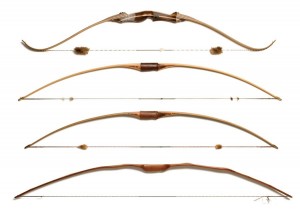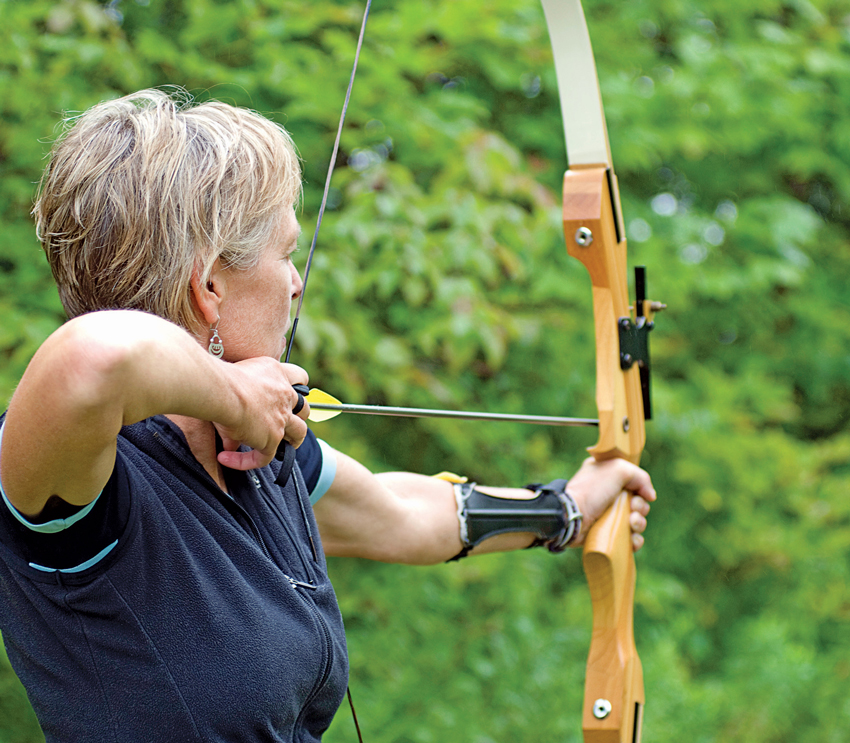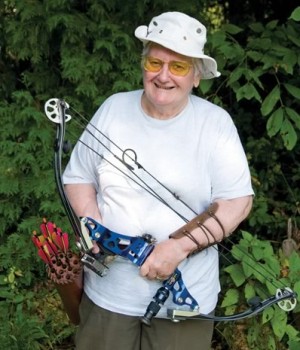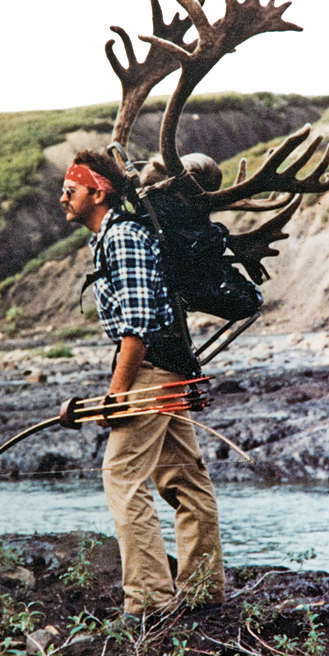Straight Arrow: Lessons in a Steady Hand and a Sharp Eye
Lessons in archery from the steady hand and a sharp eye of Bruce Savage.
First, we have to determine whether you are right-eye or left-eye dominant,” says Bruce Savage, my accomplished archery instructor. Bruce’s successful wish list in the sport he loves can only be topped if his daughter, Racheal, makes it to competition in the 2012 Olympics. She was the team’s alternate for the games in Athens and Beijing.
A long-time Caledon resident, Bruce explains that about 25 per cent of the time, a right-handed person is left-eye dominant (or vice versa). When that happens the eye overrules the hand. Your dominant eye determines depth, and it’s easier to learn the mechanics than depend on the wrong eye.
I’m right-eye dominant, so Bruce pulls a right-handed recurve bow out of a cabinet filled with dozens of these elegant double-bent bows. There are some compound bows too, but for lessons, the recurve is the “weapon” of choice; it is also what Racheal, will use in London if she makes the cut.
The Archers of Caledon on Shaw’s Creek Road, south of Belfountain, is one of two archery clubs in the hills. The other is the Dufferin-Northern Peel Hunters’ & Anglers’ Association on Mono’s Five Sideroad, north of Orangeville.
Only the Caledon facility has an indoor range and, in fact, the Archers of Caledon’s ten heated indoor lanes compose one of only two such facilities in the Greater Toronto Area. For this reason, it attracts some top-notch archers.
The day I’m there, I speak with Torontonian Crispin Duenas. He competed at the Beijing Olympics, hopes to make the London team and is a role model for 16-year-old Sean Delaporte. A tall, good-looking kid who recently graduated from Erin District High School, Sean competed in his first national competition this year.

Brian Oates’ extensive collection of bows includes these (above, top three) made by master Montana bowyer Dick Robertson.
I ask Sean what he likes about archery and he tells me it’s the combination of the friendly, laid-back camaraderie at the Caledon club and the discipline. “My background is in the cadets, so I like the discipline.”
A young Scandinavian couple are the only other people shooting indoors as I make my way onto a lane. Fortunately, Bruce sets me up on the other side of the shooting range, hidden from the view of these experts, and half again as close to the targets. I may have a dominant right eye, but from where these seasoned archers shoot, I would hardly be able to see, much less hope to hit, the target.
I attended Mayfield Secondary School which had an archery program at the time. I recall loving it. As Sean pointed out, there is something highly disciplined and precise about the sport, but it’s also simple – just you, a bow, three arrows and a target.
These days, few high schools offer archery. Sometimes it’s because they don’t have the equipment; sometimes it’s because there is no qualified instructor; but as often as not, it’s because some schools discourage teaching a sport related to hunting.
Bruce puts a rubber tube in my hand and shows me how to hold it as if it were a bow. I pull back on the rubber and let it go. It’s something he does with all of the students who flock to the Archers of Caledon’s popular instructional program. Bruce wants me to let my right shoulder recoil after releasing the rubber. He also gets me to cock my left elbow in a way that will prevent the string from burning the inside of my arm. After a few tugs on the rubber tube, I’m ready for a real bow.
Bruce gives me a leather strip that protects my inside elbow – I guess people don’t always remember to cock their arm, helps me fit a leather protector on to my right, string-pulling hand, and has me straddle a line ten metres from the target. He puts the bow in my left hand, helps me fit the bowstring into the slot in the feathered end of the arrow and then rest the arrow’s shaft on a small ledge built into my bow.
He shows me how to wrap three fingers on my right hand around the string – the arrow fits between two of my leather-clad fingers – and pull the string back until it touches my nose. Then he reminds me to cock my left elbow and raise my right, string-pulling elbow high into the air. Finally, he repeats his earlier direction about allowing my right arm to recoil.

Writer Nicola Ross takes aim on the outdoor range at The Archers of Caledon. Photos by Pete Paterson.
Given everything there is to remember, I forget about the target. In fact, I don’t even notice that there is no bull’s eye on the wall ahead of me – only a white rectangular piece of spongy material. Feeling amazingly comfortable given the raft of last-minute instructions, I let the arrow go, aiming vaguely toward the front of the room.
My shoulder doesn’t exactly recoil as Bruce had hoped, but my arrow hits the square rectangle, which makes me smile. When I remark on it, Bruce replies with a line he must have repeated hundreds of times to beginners: “Our goal at this point is to keep the arrow in the building.”
Bruce’s daughter Racheal, 29, repeats the phrase when I talk to her. A Mayfield grad as well, she learned the sport from her dad, spending countless hours at the archery club along with her older brother Eric. Racheal got off to an early start, competing in Ontario’s Summer Games before reaching her teens. Then she gave archery up for a few years before deciding to get serious.
In 1997, Racheal competed in the Canada Summer Games in Brandon, Manitoba. She tells me that so far, that was the best experience of her archery career. Not only did she win gold in both the individual and team events, but her dad was her coach and her brother Eric competed too. “I remember hearing Eric cheering me on from the bleachers,” she says.
At a competition in Colombia in 2003, she raised the eyebrows of archery’s élite. With an unexpected top-three placing, Racheal won Canada its first Olympic spot for a female archer in sixteen long years. Problem was, she earned a spot for Canada, not for herself.
To determine who would get to use the berth, organizers set out a number of standards that archers had to meet. Only Racheal and one other woman made the grade. The next step was a head-to-head competition between the two. When the final arrow flew, it was Racheal’s opponent who captured the Olympic dream and made the trip to Athens.
Back at the archery range where Racheal spends so much time, I try my luck with two more arrows. You shoot three before retrieving them from the target. My second misses the rectangle and clatters to the floor. With my third attempt, I make sure to recoil my shoulder as Bruce has instructed. It works. The arrow zings off my string and whizzes cleanly through the air, embedding itself in the spongy material. It feels pretty neat.
I’m the only one using this half of the range, so Bruce and I amble down to pick up my arrows. Normally, everyone shoots, everyone puts down their bows, and then everyone goes to retrieve their arrows at the same time. “It’s not a dangerous sport,” Bruce assures me, and it’s rules like these that make it that way.
Bruce attaches a large bull’s eye to the white rectangle and when I set up to shoot again, he adjusts a small pin that is attached to the bow. He has me align the pin with the centre of the target. I get a clean shot off, but it hits just above the coloured rings. Not your fault, Bruce assures me as he raises the pin to compensate. My next shot is worse, not better, but once again I’d forgotten to recoil my right shoulder.
With my third set of three arrows, I manage to hit the bull’s eye. I can’t resist cheering, and Bruce smiles too. Despite the huge number of lessons he’s given, and even though he instructs some of Canada’s finest archers, he shares my joy.
With a bull’s eye under my belt, we move outdoors. I’m advancing ahead of my actual skill level, but I’d asked Bruce for the entire experience, and what really intrigues me are the outdoor field and 3-D courses that marry archery with a little bit of golf.
Both the Archers of Caledon and the Dufferin-Northern Peel facilities have outdoor archery courses. The latter is a busy place on Saturday mornings, according to long-time member and executive Bob Clarence. That’s when twenty or more people show up, split into threesomes or foursomes, and spend an hour or more walking through forest and field from target to target.
While the Caledon club has two field courses where you shoot at traditional bull’s eye targets, both clubs have 3-D courses. Somewhat real-looking deer, elk, moose, bears and even rabbits are set out, and each member of the foursome shoots at them from different distances, before moving on to the next target.
Personally, the idea of shooting at animal targets, even if they are made of sponge, makes me uncomfortable. I’m not against hunting, especially bow hunting, when it’s ethical and people eat what they take, but I can’t bring myself to aim at these animals. I am content to try my hand at the bull’s eyes. Whereas members of the Caledon club are mostly target shooters, the Dufferin-Northern Peel facility caters to hunters. There are always exceptions, however. And when I spoke to one of them, I came across a target shooter with a story.

Avid archers Charlotte and Ivan Lathwell have an archery range on their Erin property. Photo by Pete Paterson.
Charlotte and Ivan Lathwell moved from Toronto to a small acreage near Erin almost forty years ago. Ivan, now 74, explains that he’s from “Robin Hood country.” He grew up in Nottingham with a bow in his hand.
He hunts, but these days you can find him at the Dufferin-Northern Peel club most Saturday mornings. You can identify him by his signature red, blue, yellow and green arrows that he assembles himself and adorns with his school colours. “It’s a matter of cost really. Commercial arrows cost about $200 for a dozen,” he explains.
When Bob suggested I call Ivan to learn about his arrows, he told me to talk to Charlotte also, because “she can outshoot anyone at the club.” And indeed, her fifty or more archery trophies almost double those of her husband.
“In Scotland,” Charlotte tells me proudly, “I held the British award for ballroom dancing.” It seems a long way from crystal chandeliers and stiletto heels to bows and arrows, but sometime after she arrived in Canada and under Ivan’s tutelage, Charlotte turned into an avid kayaker, learned to shoot a rifle, and eventually became an accomplished archer.
Now 79 and limited to a walker by two replacement knees, Charlotte continues to shoot the targets set up behind the couple’s house, and as recently as four years ago was still competing.
Charlotte explains how she managed to get to most but not all of the targets at a tournament in Galt, Ontario, by slowly moving with her walker over the rough ground on the course. In the end, she placed second, losing to a thirty-year-old who had to shoot at every single target in order to outscore Charlotte. Kicking herself even today, she tells me, “All I had to do was shoot at one more target and I would have won. I could have slowly taken my walker to another target, but the ground was rough and I was nervous.”
Maybe there is inspiration for Racheal Savage in Charlotte’s dogged determination. It turns out that Racheal was once again the alternate to the Olympic team in Beijing. This time it wasn’t Racheal who won Canada’s spot, but she, along with two others, made the standard and had to compete in a shootout. “Always the bridesmaid, never the bride,” she quips.
But Racheal is back into serious training because next year she will be vying for that Olympic berth again. Perhaps if she imagines Charlotte in her walker making her slow determined progress to one more target, it will help her capture that spot in London and fill her Dad’s quiver of archery dreams.
A Hunter’s Tale
With the timing and language of a gifted storyteller, Brian Oates is relating to me his most fulfilling hunting experience – one when he didn’t shoot anything.
Brian can’t remember a time when he wasn’t interested in archery, and over the years that I’ve known this Erin native, we’ve often had heated discussions about hunting. Why not just use a camera if it’s all about the experience and intimacy with your prey? Why do you need to kill the poor beast, I want to know?
But in truth, I’m playing devil’s advocate. There is something primordial about hunting and though I have never shot an animal and hope I never will, I would if I had to. Besides, I can’t help thinking that eating what you kill is about as pure a relationship between humans and their sustenance as it gets.
I also recognize that there is some-thing about a real-life chase, the cunning of the animal, wanting to under-stand, to outsmart, to outwit. For Brian and for ethical hunters like him, the chase needs to end in more than a photograph – either the prey wins or the hunter does.
Or sometimes, maybe both come out victors.
The sun was past its zenith when Brian headed out to hills behind his house that November day. The fields he travelled were as much a part of him as the crow’s feet that appeared at his temples each time he checked the horizon for white-tailed deer.
A snowfall earlier in the week had turned the fields virgin white. Then a warm spell brought rain. That day, the temperature had plummeted, crystallizing the snow. It was frigid. “Every time I brushed past a tree, ice would fall from it on to the icy surface,” Brian says. “It sounded as if someone was throwing glass bottles in an empty gymnasium.”
He traversed a low spot and was climbing up a hill through a thicket of dogwoods when he put up three does and a nice buck. “I followed them, one step, two steps, just like a deer would move.”
He remembers that the clouds had cleared and light was good. Then he spotted a little six-pointer checking out the does. It was rutting season, after all. “I played cat and mouse with him through the dogwoods and cedars for about forty-five minutes, maybe longer,” he says.”
Brian followed the buck to an old cornfield at the top of a hill and then paused to gaze over the open landscape below. The taffeta surface of crusted snow sparkled in the afternoon sun’s oblique rays. Minutes later, the fiery ball dipped below the horizon, and Brian unstrung his long bow. Bow hunting is only legal when the sun is up.
An “instinctive shooter” in that he uses no sights, Brian’s preferred weapon is what is referred to as a “stick” bow, since it is little more than a piece of wood and a string. Popular in ancient Britain because of how quickly they could be loaded with arrows, long bows require a bit more strength than the more elegant recurve bows, which are used in Olympic competition. But they are far simpler than the highly technical compound bows with their hooks and pulleys, or lethal crossbows, which are more Schwarzenegger than Robin Hood.
Brian has made at least a dozen bows himself, has a basement filled with partially made ones, and pieces of wood that may someday become bows. Nonetheless, he hunts with bows that are custom-made, individually named and autographed by Dick Robertson of Stykbow in Montana. That day he was using “Sun Dog,” his winter bow. Made of flexible bamboo with walrus tusk ivory tips, it is lighter than its fair-weather cousins, which are made from red elm or ironwood or osage – or even yew, if you have the money.
Brian left the cornfield and headed down into the open land where he stopped to gaze back through his binoculars. Although he had unstrung his bow, he hoped to spy his prey one more time.
With a full moon rising, Brian got his wish. The young buck left the cornfield, hopped a fence and was heading his way. “I had a white top on and white camouflage pants,” he recalls, “so the buck couldn’t see me.” Then Brian used his grunt horn to pull the deer in closer.
“I bet if I’d reached out like this with my bow, I could have touched him,” he tells me, his eyes doe-like with the memory. “He’s sort of looking right through me. I’m just standing there, not moving, and I see his nose working, but the wind is coming to me and now, because of the freezing rain, everything is jewels in the moonlight. Everything is sparkling, it’s unbelievable and if I had to feed my family, I could have shot him right there, but I didn’t have to feed my family, I didn’t have to eat that night, and so I’m looking at him and smiling to myself and that is how close I got.”
In the breathless silence that followed, I asked: “Were you tempted to shoot him?”
“I knew I could and that was the reward. To get that close, to get that intimate with the animal…So I spoke to him. I said, ‘Look buck, it’s your lucky day.’
“And his eyes went bang because I moved my hands and he saw me. It was like he was thinking: ‘Holy! Holy! Holy! Holy!’
“He didn’t know where to go and he’s moving from side to side and all of a sudden – you know that blow, that grunt – and he’s stomping his feet and then he jumps straight up into the air and he lands and he’s bounding away from me, and he’s crashing and the crusted snow is exploding each time he lands. He goes in a long arc and he goes back up into the cornfield and I could still hear him going “hoosh, hoosh, hoosh” as he disappeared into the night. So I turned around and just walked home.
“And that’s my most fulfilling hunting experience.”
“But you practically scared him to death,” I offer.
“No,” says Brian after a long pause during which I can tell he really is pondering my suggestion. “No,” he repeats. “He probably got a pretty good education out of the deal.”
More Info
The Archers of Caledon on Shaw’s Creek Road, south of Belfountain, is one of two archery clubs in the hills. The other is the Dufferin-Northern Peel Hunters’ & Anglers’ Association on Mono’s Five Sideroad, north of Orangeville.







